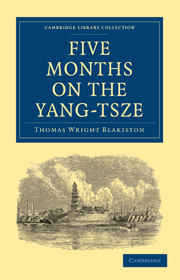 Five Months on the Yang-Tsze
Five Months on the Yang-Tsze Book contents
- Frontmatter
- PREFACE
- Contents
- LIST OF ILLUSTRATIONS
- CHAPTER I UP TO NANKING
- CHAPTER II THE MING TOMBS
- CHAPTER III THE TAIPINGS AT THEIR CAPITAL
- CHAPTER IV A NAVAL SQUADRON INLAND
- CHAPTER V ADMIRAL HOPE'S EXPLORATION
- CHAPTER VI JUNK TRAVELLING IN HOO-PEH
- CHAPTER VII SHI-SHOW TO I-CHANG
- CHAPTER VIII GORGES AND RAPIDS
- CHAPTER IX EASTERN SZ'CHUAN
- CHAPTER X VISITS AND CEREMONIES
- CHAPTER XI THE GOLD-SAND RIVER
- CHAPTER XII CROSS RANGES
- CHAPTER XIII CHUNG-KING
- CHAPTER XIV THE FOUR VALLEYS
- CHAPTER XV SÜ-CHOW AND THE WESTERN REBELS
- CHAPTER XVI PING-SHAN — OUR FARTHEST
- CHAPTER XVII THE UPPER YANG-TSZE
- CHAPTER XVIII DOWN THE KIN-CHA KIANG
- CHAPTER XIX RETURN FROM THE INTERIOR
- APPENDIX
CHAPTER XI - THE GOLD-SAND RIVER
Published online by Cambridge University Press: 28 April 2011
- Frontmatter
- PREFACE
- Contents
- LIST OF ILLUSTRATIONS
- CHAPTER I UP TO NANKING
- CHAPTER II THE MING TOMBS
- CHAPTER III THE TAIPINGS AT THEIR CAPITAL
- CHAPTER IV A NAVAL SQUADRON INLAND
- CHAPTER V ADMIRAL HOPE'S EXPLORATION
- CHAPTER VI JUNK TRAVELLING IN HOO-PEH
- CHAPTER VII SHI-SHOW TO I-CHANG
- CHAPTER VIII GORGES AND RAPIDS
- CHAPTER IX EASTERN SZ'CHUAN
- CHAPTER X VISITS AND CEREMONIES
- CHAPTER XI THE GOLD-SAND RIVER
- CHAPTER XII CROSS RANGES
- CHAPTER XIII CHUNG-KING
- CHAPTER XIV THE FOUR VALLEYS
- CHAPTER XV SÜ-CHOW AND THE WESTERN REBELS
- CHAPTER XVI PING-SHAN — OUR FARTHEST
- CHAPTER XVII THE UPPER YANG-TSZE
- CHAPTER XVIII DOWN THE KIN-CHA KIANG
- CHAPTER XIX RETURN FROM THE INTERIOR
- APPENDIX
Summary
Two hundred miles lay between us and Chung-king on the morning of the 18th April as we left Wan. It was our thirty-third day on the Upper Yang-tsze, and over two months since we had left Shanghai. The first few miles our course was a little east of south, after which we entered a long reach of the river in a south-westerly direction, in which we passed a short rapid called Hu-tan. The Chinese affixes which we found most common were “tan” or “chi,” each of which signifies “rapid;” “hia” meaning “gorge,” and “shun” “village.” The river was nearly half a mile in width in many places, with extensive sand and shingle flats, intermixed with reefs of rock, where were numerous gold-diggings; and the hills being less confused, and assuming more the form of ranges, gave a more open and pleasing appearance to the scenery. Some high hills were observed away to the southeast. The rock was a grey sandstone, which was occasionally scattered in blocks along the banks in great confusion. Near the tops of some of the hills were temples hollowed out in the cliffs, and approached by flights of steps. The door of one could only be reached by a ladder hanging vertically some sixty or seventy feet. We anchored for the night about fourteen miles above Wan, at the small village of Ta-chi-kow, where the latitude was determined.
The next day was one of great interest. The river varied considerably in width, but with no rapids, and only a few strong places.
- Type
- Chapter
- Information
- Five Months on the Yang-TszeWith a Narrative of the Exploration of its Upper Waters and Notices of the Present Rebellions in China, pp. 181 - 197Publisher: Cambridge University PressPrint publication year: 2010First published in: 1862


